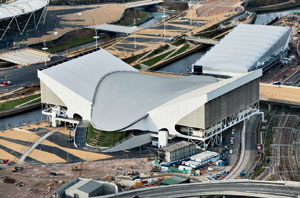Wave of the Future
Aquatics Centre
Zaha Hadid Architects
 |
Although the stadium now seems destined to be a long-term fixture in the Olympic Park, it was intended to be largely temporary. In contrast, the Aquatics Centre, designed by Zaha Hadid Architects (ZHA), from the outset was envisaged as a permanent icon—albeit one that would shed 85 percent of its 17,500 spectator seats after the Games. Within a concrete podium, and underneath a swooping roof inspired by the fluidity of water, the building houses two pools—one for swimming and one for diving competitions. A third pool, for athletes' warm-ups, is tucked below a bridge that will serve as the primary access to the center post-Olympics.
The facility has been criticized for the two winglike appendages that enclose 15,000 Olympics-mode seats. Their blocky shapes, at least from the exterior, obscure the Aquatics Centre's otherwise sinuous forms. But in order to convert the venue into a pool for community use, these wings will be “clipped” after the Games and replaced by glazed facades. As part of a PVC “take-back” policy established by the ODA, the wings' wrapping will be reclaimed by its supplier and either reused or recycled into a lesser grade of vinyl. The seats, which are leased, will be returned to the rental market. And the steel supporting the stands, made of bolted-together, standard wide-flange shapes, can be readily used in other construction projects.
Somewhat paradoxically, the sight-line requirements from the temporary stands determined the height and geometry of the 118,000-square-foot permanent roof. It sweeps in wavelike fashion from south to north over the column-free hall, dipping down between the diving pool and main pool, and tipping up at its east and west edges.
To support the doubly curved form, engineers from Arup devised a system of 10 fan trusses made up of mostly rectilinear members. The trusses span 390 feet between two transverse trusses—one bearing on a 90-foot-wide shear wall at the hall's south end, and another spanning two concrete cores 177 feet apart at the north. Purlins spanning the trusses' top and bottom chords provide attachment points for the aluminum cladding on the roof's upper surface and for red louro panels (solid in some locations and veneer-on-plywood in others) on the roof overhang and on the ceiling.
The complete truss assembly weighs about 3,500 tons. And even though a less sculptural shape might have resulted in a lighter roof, the roof members have been highly optimized for structural efficiency. According to the ODA, the realized roof scheme has a 95 percent utilization factor (a ratio of actual to permitted stress). “None of the sections is being lazy,” explains Glenn Moorley, ZHA project architect.









